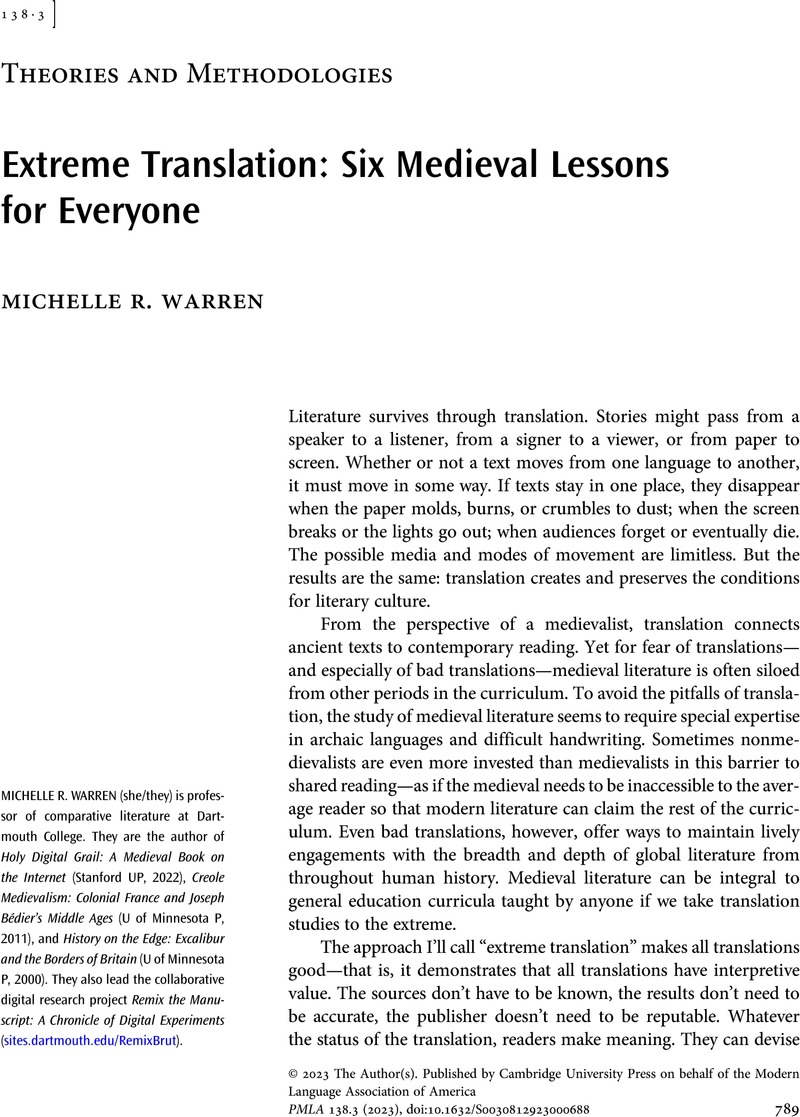No CrossRef data available.
Article contents
Extreme Translation: Six Medieval Lessons for Everyone
Published online by Cambridge University Press: 12 September 2023
Abstract
An abstract is not available for this content so a preview has been provided. Please use the Get access link above for information on how to access this content.

- Type
- Theories and Methodologies
- Information
- Copyright
- Copyright © 2023 The Author(s). Published by Cambridge University Press on behalf of the Modern Language Association of America
References
Works Cited
Armillas-Tiseyra, Magalí, translator. “The Prologue to Grammar of the Castilian Language (1492).” By Nebrija, Antonio de, PMLA, vol. 131, no. 1, Jan. 2016, pp. 202–08, https://doi.org/10.1632/pmla.2016.131.1.197.Google Scholar
Comfort, W. W., translator. Arthurian Romances. By de Troyes, Chrétien, Everyman's Library, J. M. Dent and Sons, 1914. WikiSource, en.wikisource.org/wiki/Cligès.Google Scholar
Cordell, Ryan. “‘Q i-jtb the Raven’: Taking Dirty OCR Seriously.” Book History, vol. 20, 2017, pp. 188–225. Project MUSE, https://doi.org/10.1353/bh.2017.0006.CrossRefGoogle Scholar
Drimmer, Sonja. “The Manuscript Copy and the Printed Original in the Digital Present.” Introduction. Digital Philology, vol. 9, no. 2, 2020, pp. 93–119. Project MUSE, https://doi.org/10.1353/dph.2020.0007.Google Scholar
Galderisi, Claudio, and Agrigoroaei, Vladimir. “The Langue d'Oïl (and the Langue d'Oc) in the Mirror of Translation: Bringing into Perspective French-Speaking Translation in the Middle Ages.” Translation in Europe during the Middle Ages, edited by Borsari, Elisa, Peter Lang, 2020, pp. 29–62.Google Scholar
Gardner, L. J., translator. Cligès: A Romance. By Troyes, Chrétien de, Project Gutenberg, www.gutenberg.org/files/2414/2414-h/2414-h.htm. Accessed 14 Aug. 2022.Google Scholar
Harkness, Albert, editor. Preparatory Course in Latin Prose Authors. 1882. Bibliolife, 2015. War College Series.Google Scholar
Hedeman, Anne D. Visual Translation: Illuminated Manuscripts and the First French Humanists. U of Notre Dame P, 2022.Google Scholar
Hult, David F. “Manuscript Transmission, Reception and Canon Formation: The Case of Chrétien de Troyes.” Morrison Library Lecture Series, no. 13. U of California, Berkeley, 1998, escholarship.org/uc/item/1s57v338.Google Scholar
Kasten, Ingrid, translator. Cligès: Auf der Grundlage des Textes von Wendelin Foerster. By de Troyes, Chrétien, Walter de Gruyter, 2006. EBSCOhost, https://doi.org/10.1515/9783110201543.CrossRefGoogle Scholar
Kirschenbaum, Matthew. “Prepare for the Textpocalypse.” The Atlantic, 8 Mar. 2023. www.theatlantic.com/technology/archive/2023/03/ai-chatgpt-writing-language-models/673318/.Google Scholar
Kirschenbaum, Matthew, and Werner, Sarah. “Digital Scholarship and Digital Studies: The State of the Discipline.” Book History, vol. 17, 2014, pp. 406–58.CrossRefGoogle Scholar
Kline, Anthony, translator. Cligès. By de Troyes, Chrétien, Poetry in Translation, 2018, www.poetryintranslation.com/klineascliges.php.Google Scholar
Newell, William Wells, translator. King Arthur and the Table Round: Tales Chiefly after the Old French of Crestien of Troyes. 2 vols., Houghton Mifflin, 1897. Google Books, https://www.google.com/books/edition/King_Arthur_and_the_Table_Round/ZD9AAAAAIAAJ.Google Scholar
Raley, Rita and Rhee, Jennifer, editors. Critical AI: A Field in Formation. Special issue of American Literature, vol. 95, no. 2, 2023.Google Scholar
Rosa, Jonathan. Looking Like a Language, Sounding Like a Race: Raciolinguistic Ideologies and the Learning of Latinidad. Oxford UP, 2019.CrossRefGoogle Scholar
Roustant, Sylvia. “Philomena de Chretien de Troyes: Métamorphose d'une métamorphose au temps du roman.” Carnets, vol. 5, 2013. OpenEdition Journals, https://doi.org/10.4000/carnets.8240.Google Scholar
Smalley, Beryl. “Sallust in the Middle Ages.” Classical Influences on European Culture, A.D. 500 to 1500, vol. 1, edited by Bolgar, R. R., Cambridge UP, 1971, pp. 165–76.Google Scholar
“Submitting Manuscripts to PMLA.” Modern Language Association, www.mla.org/Publications/Journals/PMLA/Submitting-Manuscripts-to-PMLA. Accessed 14 Aug. 2022.Google Scholar
Uitti, Karl D, and Freeman, Michelle A.. Chrétien de Troyes Revisited. Twayne Publishers, 1995.Google Scholar
Warren, Michelle R. Holy Digital Grail: A Medieval Book on the Internet. Stanford UP, 2022.CrossRefGoogle Scholar
Warren, Michelle R. “The Politics of Textual Scholarship.” The Cambridge Companion to Textual Scholarship, edited by Fraistat, Neil and Flanders, Julia, Cambridge UP, 2013, pp. 119–33.Google Scholar
Warren, Michelle R. “Translating in the Zone.” New Medieval Literatures, vol. 9, 2007, pp. 191–98.CrossRefGoogle Scholar
Warren, Michelle R. “Translation.” Oxford Twenty-First Century Approaches to Literature: Middle English, edited by Strohm, Paul, Oxford UP, 2007, pp. 51–67.Google Scholar
Webb, J. R. “‘Knowledge Will Be Manifold’: Daniel 12.4 and the Idea of Intellectual Progress in the Middle Ages.” Speculum, vol. 89, no. 2, 2014, pp. 307–57. JSTOR, www.jstor.org/stable/43577117.Google Scholar
Wolfram, Stephen. “What Is ChatGPT Doing … and Why Does It Work?” Writings, 14 Feb. 2023, writings.stephenwolfram.com/2023/02/what-is-chatgpt-doing-and-why-does-it-work/.Google Scholar


